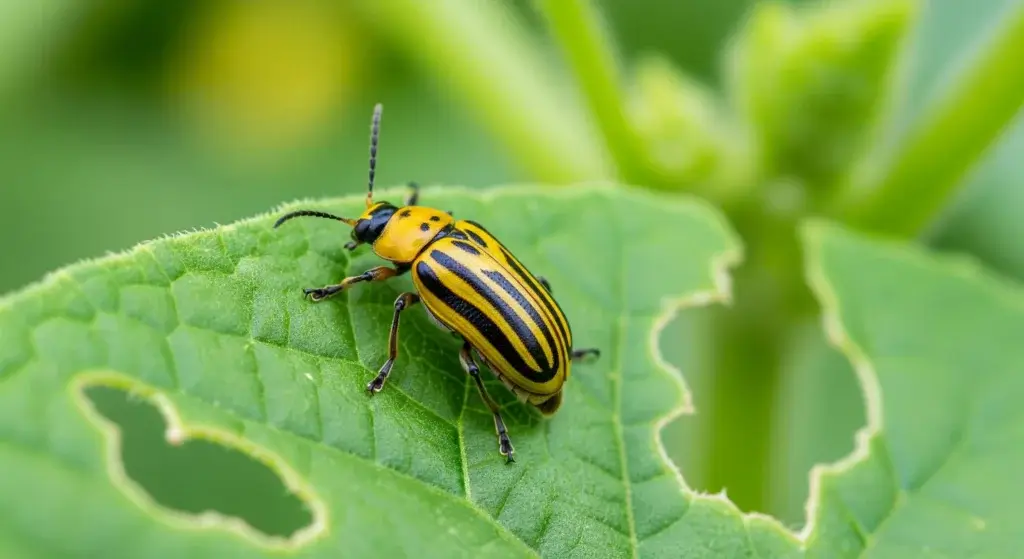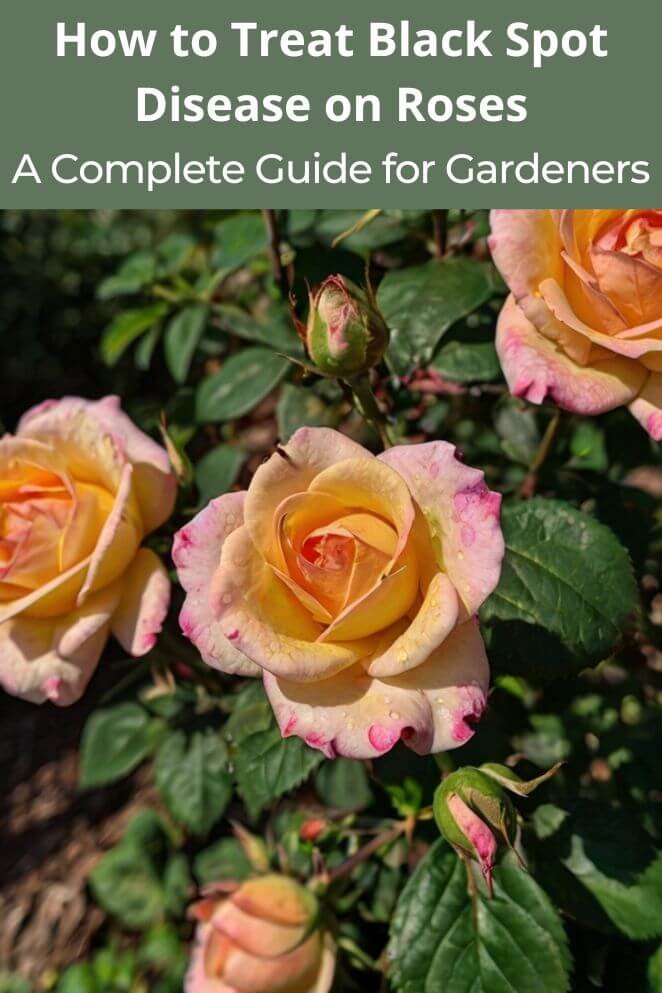
Roses are the superstar of any garden, but even these beauties can get a serious case of “black spot”—a pesky fungal villain that loves to mess with your plants if you let it.
Whether you’re just starting out or have been rocking roses for years, knowing how to spot, fight, and stop black spot is your secret weapon for keeping your blooms looking fabulous all season.
In this guide, we’ll break down what black spot disease actually is, how to spot its ugly signs, and the top tricks—both natural and chemical—to kick it to the curb.
With a little TLC, your roses will be back to stealing the show in no time!
What Is Black Spot Disease?
Black spot (fancy name: Diplocarpon rosae) is the ultimate party crasher for your roses.
It shows up as nasty, round black spots with feathery edges on the leaves — basically a fungal attack that’s more than just ugly.
These spots can seriously weaken your roses, make them drop leaves early, and kill their vibe by cutting down on blooms.
Here’s the lowdown:
- Black or dark brown circles with messy edges
- Leaves turn yellow starting from the bottom like they’ve caught a bad case of the Mondays
- Leaves drop off way too soon — not cool!
- Loves humid, wet weather, so it’s basically a spring and early summer stalker
The Royal Horticultural Society says black spot is the worst rose disease worldwide, and honestly, pretty much every rose variety is at risk.
Think of it as the Voldemort of rose problems — you definitely want to defeat it before it takes over your garden.
- Read also: Blooms Without Bugs: Natural Pesticides for Your Roses
- Read also: Tiny Terror: A Guide to Aphid Control on Your Roses
How to Identify Black Spot Disease
Catching black spot early is like spotting a plot twist before it ruins the whole story—super important if you want your roses to stay fabulous.
Here’s what to look for:
- Leaves show up with black, ragged-edged spots that get bigger like they’re spreading gossip
- The skin around the spots turns yellow, then basically gives up and dies
- Those sad leaves drop off early, like they’re ghosting your garden
- Spots usually start low down on older leaves, like a sneaky ninja attack from below
Pro tip: Flip the leaves over and check the undersides—fungus loves hiding in moist, shady spots, like it’s camping out for a horror movie sequel. Keep your eyes peeled!
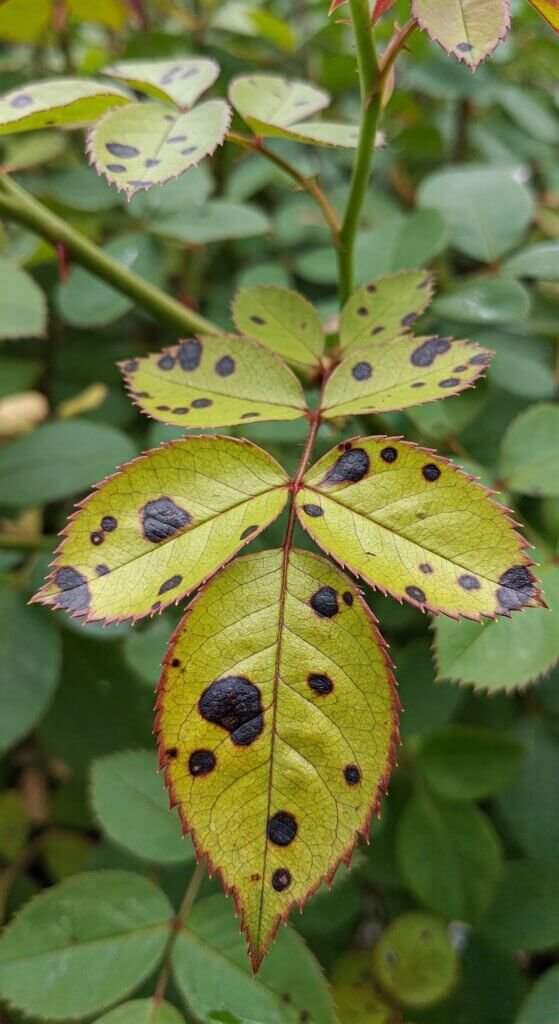
Causes and Conditions That Favor Black Spot
To keep black spot from throwing shade on your roses, you gotta know what it loves:
- Leaves staying wet for more than 6 hours (like after a rainy Netflix binge)
- Humidity levels cranked up like a sauna session
- Bad air flow—roses need to breathe, not feel like they’re stuck in traffic
- Watering from above or lots of rain splashing around (fungus loves a wet runway)
- Dirty plant trash hanging out at the base, like a fungal hangout spot
Bonus bad news: This sneaky fungus spreads its spores like it’s sending viral memes—via wind, water, and even your pruning shears. So keep things clean and breezy!
How to Treat Black Spot on Roses
Got black spot crashing your rose party? No sweat—here’s your game plan to fight back, whether you’re all about that natural vibe or ready to bring in the big guns.
1. Organic treatments
Keep it eco-friendly and pet-friendly with these homegrown heroes:
Neem oil spray
Think of neem oil as the ninja of natural fungicides—also scares off bugs.
- Mix 2 tablespoons neem oil + 1 teaspoon dish soap into 1 gallon of water
- Spray the whole plant, top and bottom of leaves
- Repeat every 7–10 days while the fungus is acting up
Baking soda solution
This old-school trick messes with the fungus’s vibe by changing leaf pH.
- Combine 1 tablespoon baking soda + 1 teaspoon dish soap + 1 gallon water
- Spray weekly during growing season to keep fungus guessing
Compost tea
It’s like a health smoothie for your plants, boosting their immune system and crowding out the bad guys.
Spray it on leaves and let your roses sip up the benefits.
2. Chemical fungicides
If the organic squad can’t handle it, time to call in the pros:
- Daconil® (chlorothalonil)
- Spectracide® Immunox® (myclobutanil)
- Bonide Fung-onil®
Switch up your fungicides regularly so the fungus doesn’t learn your moves.
Apply every 7–14 days, especially when things get wet and humid.
3. Pruning and cleanup
Trash talk with the fungus by cutting out its hangout spots:
- Snip infected leaves and stems ASAP
- Wipe your pruning shears with rubbing alcohol between cuts (think of it as a mini sanitizer for your tools)
- Toss infected bits in the trash—no compost parties for fungus leftovers!
- Boost airflow by thinning crowded areas and trimming low leaves—roses hate feeling suffocated.
Follow these steps, and your roses will be back to throwing their best petal party in no time!
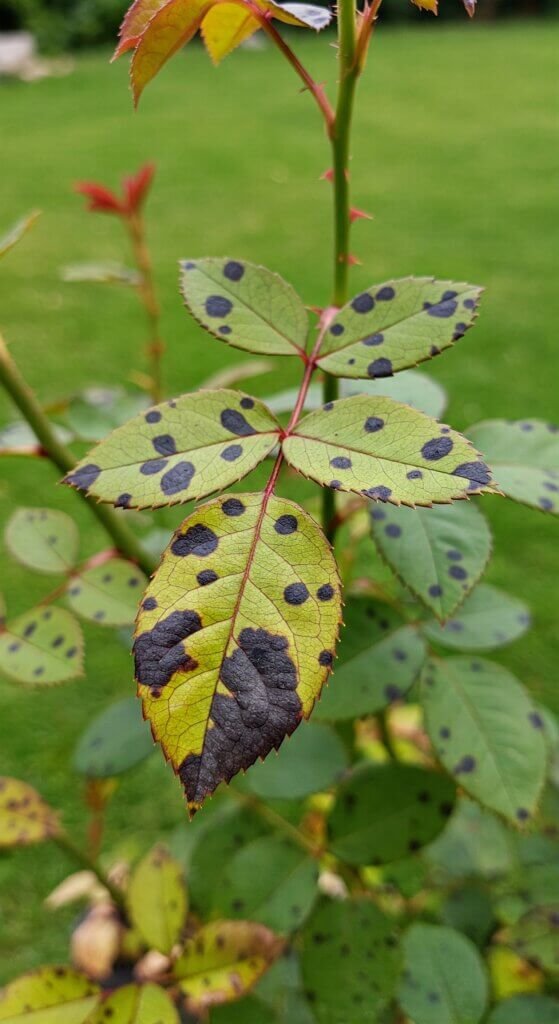
How to Prevent Black Spot in the Future
So you’ve battled black spot and won—nice! Now, let’s make sure it doesn’t crash the party again.
Here’s your rose’s personal security detail:
1. Water like a pro
Keep the splash drama to a minimum by watering at the base, not from above.
Bonus points if you water early—letting leaves dry before bedtime means less fungus-friendly moisture.
Think of it like giving your roses a morning shower, not a midnight pool party.
2. Mulch: Your soil’s best friend
Spread 2–3 inches of organic mulch around the roots.
Mulch acts like a ninja shield, stopping dirty water (and pesky spores) from splashing up onto leaves.
Plus, it keeps the soil cozy and moist—win-win.
3. Choose disease-resistant rose varieties
Some roses come ready-made with defense shields against black spot.
Try crowd favorites like:
- ‘Knock Out®’ (because it knocks out disease)
- ‘Carefree Beauty’ (sounds chill, right?)
- ‘Ballerina’
- ‘Bonica’
These varieties play hard to get when it comes to fungal infections and are pretty low drama overall.
4. Give your roses some personal space
No one likes feeling cramped—roses included.
Plant them at least 2–3 feet apart and prune regularly to keep the air flowing.
Think of it like social distancing for plants; it keeps fungus from throwing a humid house party.
5. Seasonal sprays: The winter coat for roses
Before spring, give your roses a protective bath with dormant oil or fungicidal sprays.
This cleans up any sneaky spores hanging out from winter, so they don’t ruin your rose’s glow-up.
Pro tip: Taking these steps during dormancy is like prepping for a big battle—it saves you headaches later in the growing season.
Black Spot Treatment Checklist
Use this quick reference to keep your rose care routine in check:
| Task | Frequency | Purpose |
| Inspect leaves | Weekly | Early detection |
| Prune infected leaves | As needed |
Remove spore sources
|
| Apply neem oil or fungicide | Every 7–14 days | Control spread |
| Water at base | Daily/as needed |
Reduce leaf wetness
|
| Clean up debris | Ongoing |
Eliminate overwintering fungus
|
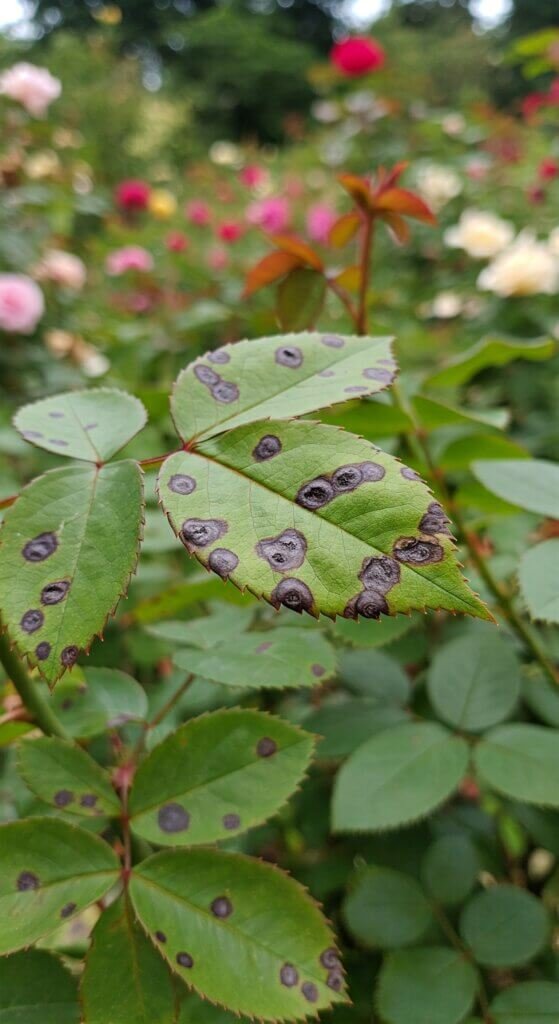
Eco-Friendly Tip: Encourage Natural Predators
A garden that’s buzzing with ladybugs, lacewings, and other good bugs is like having a pest-fighting squad on your team.
These natural predators chow down on pests that stress your roses and make them easier targets for diseases like black spot.
Planting buddies like basil, garlic, or marigolds isn’t just pretty—they also act like natural pest repellents, giving your garden some extra muscle without chemicals.
- Read also: Effective Solutions: Tips Against Powdery Mildew on Roses
- Read also: Nurturing Beauty: A Guide to Desert Rose Fertilizer Care
Conclusion: Don’t Let Black Spot Steal Your Roses
Black spot is annoying, but it’s no match for a smart gardener armed with good habits, natural tricks, and a solid game plan.
Keep your roses healthy and your garden thriving, so you can enjoy those gorgeous blooms without drama.
After all, every rose deserves its moment to shine!


